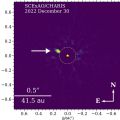Smoothsort - Définition
La liste des auteurs de cet article est disponible ici.
Etapes de l'algorithme
La première étape consiste à transformer le tableau en un arbre binaire. Le premier élément est déjà trivialement bien ordonné, puis on ajoute un à un les éléments suivants. On réordonne chaque fois un peu les éléments si nécessaire pour qu'ils correspondent aux critères :
- Chaque noeud ne peut être supérieur à son noeud parent
- Le premier noeud enfant ne peut être supérieur au deuxième noeud enfant
NB: Ces critères imposent un ordre dans le même sens que le sens trié, d'où l'intérêt de cet algorithme.
La deuxième étape consiste à retransformer l'arbre binaire en tableau trié. Chaque élément en partant de la droite est laissé tel quel car il s'agit de la racine de l'arbre qui est déjà le plus grand élément, et l'arbre restant est réordonné si nécessaire. On fait ceci jusqu'à arriver à un tableau trié.
Implémentation en C#
Implémentation accompagnée de petits exemple pour l'optimiser en fonction de structure particulière (tri de flottant, pointeur vers un objet...)
using System; using System.Collections.Generic; using System.Text; namespace NitsujMoteur { #region comparaisons public struct elem_indicéf { public float indice; public object elem; public int indiceOrig;//n'est pas rempli par le code, optionnel si besoin est. } public class indicef_comparer : IComparer<elem_indicéf> { #region IComparerMembres int IComparer<elem_indicéf>.Compare(elem_indicéf x, elem_indicéf y) { if (x.indice < y.indice) return -1; else if (x.indice > y.indice) return 1; else return 0; //return x.indice - y.indice; } #endregion } public struct elem_indicé { public int indice; public object elem; public int indiceOrig;//n'est pas rempli par le code, optionnel si besoin est } public class indice_comparer : IComparer<elem_indicé> { #region IComparerMembres int IComparer<elem_indicé>.Compare(elem_indicé x, elem_indicé y) { return x.indice - y.indice; } #endregion } public class int_comparer : IComparer<int> { #region IComparerMembres //public car dans l'interface... int IComparer<int>.Compare(int x, int y) { return x - y; } #endregion } #endregion public class Trie<T, TC> where TC : IComparer<T> { /* An algorithm developed by Edsger Dijkstra based on the same principle as * heapsort. By using a postorder traversal of a heap-like structure, O(n) * time complexity is achieved for already-sorted data. * Time complexity: * O(n log n) worst case * O(n) best case * Working memory: * O(1) all cases */ private static void up(ref int b, ref int c) { int temp = b + c + 1; c = b; b = temp; } private static void down(ref int b, ref int c) { int temp = b - c - 1; b = c; c = temp; } private static void sift(int r, int b, int c, T[] data, TC Comp) { while (b >= 3) { int r2 = r - b + c; if (Comp.Compare(data[r2], data[r - 1]) < 0)//data[r2] < data[r - 1]) { r2 = r - 1; down(ref b, ref c); } if (Comp.Compare(data[r], data[r2]) >= 0)//data[r] >= data[r2]) { b = 1; } else { swap(ref data[r], ref data[r2]); r = r2; down(ref b, ref c); } } } private static void trinkle(int r, int p, int b, int c, T[] data, TC Comp) { while (p > 0) { int r3; while (p % 2 == 0) { p /= 2; up(ref b, ref c); } r3 = r - b; if (p == 1 || Comp.Compare(data[r3], data[r]) <= 0)//data[r3] <= data[r]) { p = 0; } else { p--; if (b == 1) { swap(ref data[r], ref data[r3]); r = r3; } else if (b >= 3) { int r2 = r - b + c; if (Comp.Compare(data[r2], data[r - 1]) < 0)//data[r2] < data[r - 1]) { r2 = r - 1; down(ref b, ref c); p *= 2; } if (Comp.Compare(data[r3], data[r2]) >= 0)//data[r3] >= data[r2]) { swap(ref data[r], ref data[r3]); r = r3; } else { swap(ref data[r], ref data[r2]); r = r2; down(ref b, ref c); p = 0; } } } } sift(r, b, c, data, Comp); } private static void semitrinkle(int r, int p, int b, int c, T[] data, TC Comp) { int r1 = r - c; if (Comp.Compare(data[r1], data[r]) > 0)//data[r1] > data[r]) { swap(ref data[r], ref data[r1]); trinkle(r1, p, b, c, data, Comp); } } private static void swap(ref T x, ref T y) { T temp = x; x = y; y = temp; } public static void smoothSort(T[] data, TC Comp) { if (data.Length <= 1) return; int q = 1, r = 0, p = 1, b = 1, c = 1; while (q != data.Length) { if (p % 8 == 3) { sift(r, b, c, data, Comp); p = (p + 1) / 4; up(ref b, ref c); up(ref b, ref c); } else if (p % 4 == 1) { if (q + c < data.Length) { sift(r, b, c, data, Comp); } else { trinkle(r, p, b, c, data, Comp); } do { down(ref b, ref c); p *= 2; } while (b != 1); p++; } q++; r++; } trinkle(r, p, b, c, data, Comp); while (q != 1) { q--; if (b == 1) { r--; p--; while (p % 2 == 0) { p /= 2; up(ref b, ref c); } } else if (b >= 3) { p--; r += c - b; if (p != 0) semitrinkle(r, p, b, c, data, Comp); down(ref b, ref c); p = 2 * p + 1; r += c; semitrinkle(r, p, b, c, data, Comp); down(ref b, ref c); p = 2 * p + 1; } } } } #region spécialisation public class Trie_elem_indicéf : Trie<elem_indicéf, indicef_comparer> { public static void smoothSort(elem_indicéf[] data) { smoothSort(data, new indicef_comparer()); } } public class Trie_elem_indicé : Trie<elem_indicé, indice_comparer> { public static void smoothSort(elem_indicé[] data) { smoothSort(data, new indice_comparer()); } } #endregion }

















































